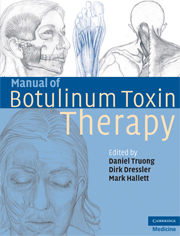Book contents
- Frontmatter
- Contents
- List of contributors
- Foreword – Alan B. Scott
- Preface
- 1 The pretherapeutic history of botulinum toxin
- 2 Botulinum toxin: history of clinical development
- 3 Pharmacology of botulinum toxin drugs
- 4 Immunological properties of botulinum toxins
- 5 Treatment of cervical dystonia
- 6 Treatment of hemifacial spasm
- 7 Treatment of blepharospasm
- 8 Treatment of oromandibular dystonia
- 9 Treatment of focal hand dystonia
- 10 Botulinum toxin applications in ophthalmology
- 11 Botulinum toxin therapy of laryngeal muscle hyperactivity syndromes
- 12 The use of botulinum toxin in otorhinolaryngology
- 13 Spasticity
- 14 The use of botulinum toxin in spastic infantile cerebral palsy
- 15 Hyperhidrosis
- 16 Cosmetic uses of botulinum toxins
- 17 Botulinum toxin in the gastrointestinal tract
- 18 Botulinum toxin in urological disorders
- 19 Use of botulinum toxin in musculoskeletal pain and arthritis
- 20 The use of botulinum toxin in the management of headache disorders
- 21 Treatment of plantar fasciitis with botulinum toxin
- 22 Treatment of stiff-person syndrome with botulinum toxin
- 23 Botulinum toxin in tic disorders and essential hand and head tremor
- 24 Developing the next generation of botulinum toxin drugs
- Index
- References
4 - Immunological properties of botulinum toxins
Published online by Cambridge University Press: 28 July 2009
- Frontmatter
- Contents
- List of contributors
- Foreword – Alan B. Scott
- Preface
- 1 The pretherapeutic history of botulinum toxin
- 2 Botulinum toxin: history of clinical development
- 3 Pharmacology of botulinum toxin drugs
- 4 Immunological properties of botulinum toxins
- 5 Treatment of cervical dystonia
- 6 Treatment of hemifacial spasm
- 7 Treatment of blepharospasm
- 8 Treatment of oromandibular dystonia
- 9 Treatment of focal hand dystonia
- 10 Botulinum toxin applications in ophthalmology
- 11 Botulinum toxin therapy of laryngeal muscle hyperactivity syndromes
- 12 The use of botulinum toxin in otorhinolaryngology
- 13 Spasticity
- 14 The use of botulinum toxin in spastic infantile cerebral palsy
- 15 Hyperhidrosis
- 16 Cosmetic uses of botulinum toxins
- 17 Botulinum toxin in the gastrointestinal tract
- 18 Botulinum toxin in urological disorders
- 19 Use of botulinum toxin in musculoskeletal pain and arthritis
- 20 The use of botulinum toxin in the management of headache disorders
- 21 Treatment of plantar fasciitis with botulinum toxin
- 22 Treatment of stiff-person syndrome with botulinum toxin
- 23 Botulinum toxin in tic disorders and essential hand and head tremor
- 24 Developing the next generation of botulinum toxin drugs
- Index
- References
Summary
Introduction
Botulinum toxins are used to treat a large number of muscle hyperactivity disorders, including dystonia, spasticity, and tremor, autonomic disorders, such as hyperhidrosis and hypersalivation, as well as facial wrinkles. Commercially available products differ with respect to serotype, formulation, and purity. Not all products are approved in all countries. Serotype A-containing products are Botox®, Dysport®, Chinese BoNT-A (CBTX-A) and Xeomin®, whereas NeuroBloc®/Myobloc® contains serotype B. The active ingredient in all products is botulinum neurotoxin (BoNT), a di-chain protein with a molecular weight of 150 kDa. Botulinum toxin type A (BoNT-A) inhibits release of acetylcholine by cleaving the soluble N-ethylmaleimide-sensitive factor attachment protein receptor (SNARE) protein SNAP 25 while BoNT type B (BoNT-B) cleaves vesicle-associated membrane protein (VAMP) II. Since BoNTs are foreign proteins, the human immune system may respond to them with the production of specific anti-BoNT antibodies (BoNT-AB). The probability of developing BoNT-AB increases with the BoNT doses applied (Göschel et al., 1997). Whether other drug-related factors might contribute to immune responses is discussed below. Patient-related factors may also be involved in triggering BoNT-AB formation. Recently, a patient was reported who was treated with Dysport for several years with good results until he developed BoNT-AB-induced therapy failure after he received BoNT following a wasp sting (Paus et al., 2006). Since components of wasp poison are effective immunostimulants, a preactivation of lymphocytes may have triggered BoNT-A-AB formation.
Information
- Type
- Chapter
- Information
- Manual of Botulinum Toxin Therapy , pp. 23 - 28Publisher: Cambridge University PressPrint publication year: 2009
References
Accessibility standard: Unknown
Why this information is here
This section outlines the accessibility features of this content - including support for screen readers, full keyboard navigation and high-contrast display options. This may not be relevant for you.Accessibility Information
- 1
- Cited by
